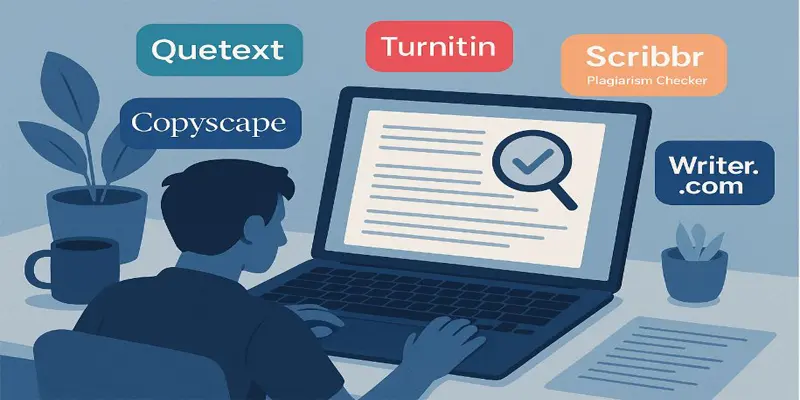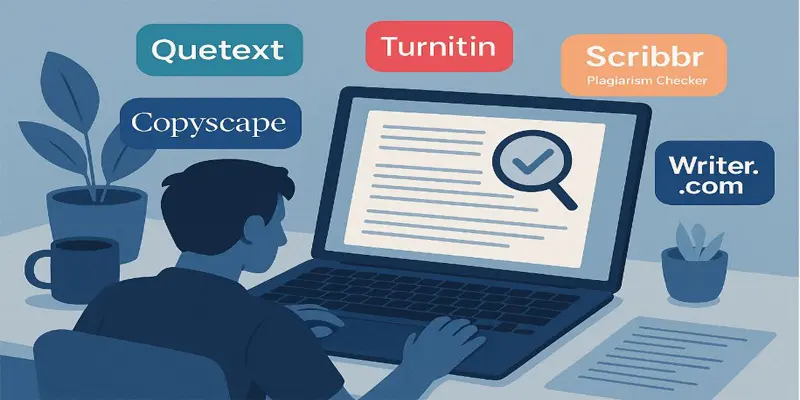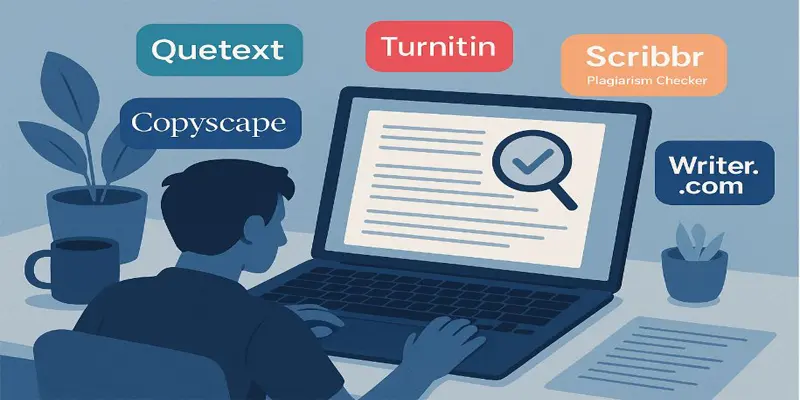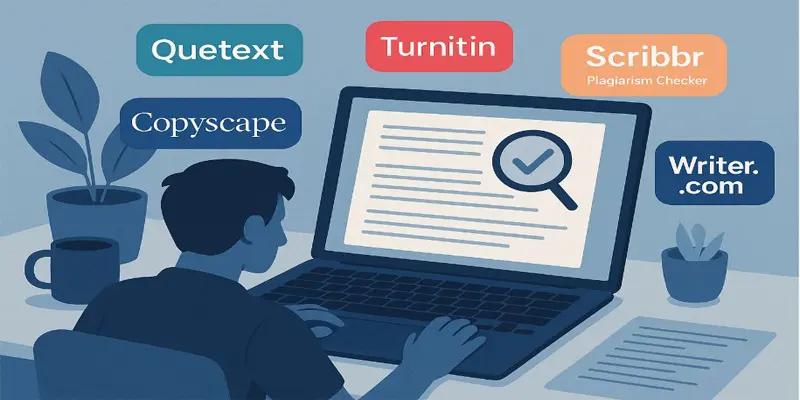Why AI Tools Are Reshaping Research in this year
The pace of academic and industry research has exploded. With millions of papers published each year and data doubling at record speed, researchers can no longer afford to rely solely on traditional methods. AI has moved beyond the future—it’s now an essential part of today’s world. In 2025, artificial intelligence is transforming every layer of research, from literature reviews and content discovery to scientific writing, trend analysis, and originality verification.
Whether you're a university scholar, a market researcher, or a pharmaceutical scientist, today's AI tools offer targeted support for every step of the research process. This guide explores the top 7 AI tools for researchers and how to build a tailored research stack that works smarter — not harder.
1. Elicit by Ought – Smarter Literature Reviews Without the Manual Work
Keeping up with academic literature is like drinking from a firehose. Elicit simplifies that challenge.
What is Elicit and how does it work? Elicit is an AI-powered research tool designed to streamline and automate literature reviews. It uses machine learning to extract answers from academic papers based on your research question. Instead of reading dozens of abstracts manually, Elicit fetches the most relevant studies and breaks them down into structured, easy-to-digest summaries.
Who should use it and when is it most valuable?
Elicit is ideal for academics, PhD candidates, and policy researchers who are exploring new topics or forming a hypothesis. It’s particularly powerful in the early phases of a research project when breadth of understanding matters most.
Key features that make it a research game-changer
· Automatically finds and summarizes peer-reviewed literature
· Displays study participants, outcomes, and methodologies in table form
· Prioritizes papers with strong evidence and relevant findings
· Integrates with Zotero for easy citation management
Pro tip: Use Elicit to refine your literature gap before submitting a research proposal.

2. Ahrefs AI – Data-Driven Research for SEO, Market & Search Trends
Beyond being an SEO staple, Ahrefs AI is now a strategic tool for researchers focused on digital behavior, competitive analysis, and market trends.
What makes Ahrefs useful beyond content marketing? Ahrefs AI combines web crawler insights with keyword intelligence to show how people think, search, and engage online. Researchers in fields like behavioral science, media studies, or even political science can tap into public sentiment, emerging interests, and topic evolution over time.
Ideal research use-cases for search and web data
· Tracking how search queries evolve on public health topics
· Analyzing misinformation trends or content virality
· Studying user behavior and content gaps in specific industries
Strengths in keyword clustering and competitive intelligence
· Topic clustering by semantic similarity
· Visual keyword explorers and search intent mapping
· Site-level backlink and content performance analysis
Pro tip: Combine Ahrefs with Google Trends for a robust dataset on public discourse.

3. BuzzSumo AI – Discover What Content and Trends Actually Work
Knowing what resonates with audiences isn't just for marketers — it's also essential for media researchers and communication analysts.
How researchers and analysts use BuzzSumo: BuzzSumo AI scans the internet to surface top-performing content across platforms. It offers insights into how ideas go viral and which headlines, formats, and sources attract the most attention.
Tracking social signals and performance metrics
· Engagement breakdowns across Facebook, LinkedIn, X, Pinterest
· Real-time alerts for trending topics
· Influencer mapping by niche or topic area
How it supports qualitative and quantitative research
· Discover narrative trends in specific sectors (e.g., climate, finance)
· Use engagement data as a proxy for public interest
· Compare sentiment and framing across outlets
Pro tip: BuzzSumo’s AI prediction score helps pre-test content impact before publication.
4. Writefull – Academic Writing Assistant Tailored for Research Papers
Good research deserves good writing — and that’s where Writefull steps in.
How Writefull supports scientific tone and structure: Writefull is an AI-based editor designed for academic writing. It goes beyond grammar checking by offering discipline-specific language suggestions and structural improvements tailored to scientific formats.
When to use it during the research writing process
It’s most useful when preparing manuscripts, journal submissions, or grant proposals. Writefull can also assist during editing rounds to boost clarity and coherence.
Key academic features: feedback, phrasebanks, and journal styles
· Feedback on scientific tone, formality, and fluency
· Discipline-specific phrase suggestions from actual published papers
· Templates and formatting for major journals like Nature, Elsevier, Springer
Pro tip: Use the ‘Writefull for Overleaf’ plugin to streamline LaTeX-based writing workflows.

5. Originality.ai – Verify Authentic Content in the Era of AI Writing
AI-assisted writing is now widespread — which raises concerns about originality and ethical authorship.
Why originality matters more than ever: With the rise of LLM-generated content, ensuring that your work is unique and properly attributed is no longer optional. Originality.ai helps identify both plagiarism and AI-written segments, providing a layer of transparency critical in academic publishing.
How it detects AI-generated and plagiarized content
· Uses advanced fingerprinting to detect GPT and other model outputs
· Checks against vast academic and web-based databases
· Scores your content for both originality and AI-likeness
Practical tips for researchers, reviewers, and editors
· Run every major section of your paper before submission
· Use it as part of your peer-review QA toolkit
· Encourage co-authors to check drafts to avoid unintentional overlap
Pro tip: Use Originality.ai post-collaboration to ensure integrity when multiple contributors are involved.
6. BioMed Explorer by Iris.ai – Deep Research for Biomedical Breakthroughs
BioMed Explorer meets the biomedical field’s need for both precision and comprehensive analysis.
How it extracts structured insights from biomedical papers: BioMed Explorer uses NLP to map out complex biomedical concepts from research papers. It identifies entities like biomarkers, diseases, drug interactions, and gene expressions, presenting them in interactive graphs.
Who it’s built for: scientists, pharma teams, med researchers
Whether you're working in drug discovery, epidemiology, or life sciences, this tool helps parse huge volumes of data in seconds, revealing connections that might otherwise remain buried.
Use-cases: biomarkers, pathways, drug interaction analysis
· Identify previously undocumented compound interactions
· Visualize mechanistic pathways across disease categories
· Conduct meta-analyses based on structured concept extraction
Pro tip: Use Iris.ai’s research map feature to brainstorm novel hypotheses based on existing literature.

7. Grammarly Premium – Elevating Clarity, Tone & Academic Polish
While Grammarly has been around for years, its Premium tier continues to evolve for research professionals.
Why it’s still a go-to tool for academic researchers: Clarity and tone can make or break a submission. Grammarly Premium helps polish arguments, tighten phrasing, and elevate professionalism — particularly for non-native English speakers.
Strengths in citation checking, formal tone, and clarity
· Ensures citations are properly formatted (APA, MLA, Chicago)
· Flags hedging language or overly casual tone
· Rewrites awkward sentences without losing nuance
Best use during editing and proofreading stages
· Final pass before manuscript or thesis submission
· Cleaning up research grant applications
· Peer-review support for improving draft readability
Pro tip: Use Grammarly’s browser extension to instantly check emails to collaborators, reviewers, or publishers.
Comparison Table: Which AI Tool Fits Which Research Purpose?
| Tool | Best For | Key Strength | Elicit | Literature reviews | Structured summaries of peer-reviewed papers
| Ahrefs AI | Market/SEO trend research | Keyword clustering & web behavior mapping
| BuzzSumo AI | Trend/social signal analysis | High-performing content discovery
| Writefull | Academic writing | Field-specific tone and journal formatting
| Originality.ai | Authenticity & plagiarism checks | AI & plagiarism detection combo
| BioMed Explorer | Biomedical discovery | Deep NLP mapping of scientific concepts
| Grammarly Premium | Final editing & tone refinement | Clarity, citations, and tone optimization
Final Thoughts: Building Your Personalized AI Research Workflow
AI tools are no longer optional in the research process — they’re essential. Whether you’re scanning literature, testing ideas, publishing papers, or exploring market trends, there’s an AI solution built to match your task.
Start with Elicit to refine your questions, use Ahrefs or BuzzSumo for external context, then write and polish with Writefull and Grammarly. For ethics and credibility, bring in Originality.ai, and if you're in the life sciences, BioMed Explorer will revolutionize your understanding.
Think of these tools not as replacements for your expertise, but as co-pilots. The smartest researchers in 2025 aren't just informed — they're augmented. Build your own AI research stack today, and you'll be future-proofed for what comes next.
How Elicit Changed My Workflow
Hi, I'm Rachel Meyers — I’ve been working in behavioral policy research for over six years now at the Evergreen Institute here in Seattle. Managing research, reading dozens of academic papers, and staying updated with new findings is honestly the most draining part of my job.
A few months back, during a really tough week, my colleague Mark (our lead data scientist) noticed I was buried under a mountain of PDFs. He suggested I try Elicit by Ought, an AI tool made specifically for researchers.
At first, I was skeptical. I thought, “Great, another tech tool that promises a lot and delivers little.” But once I gave it a try, I was kind of surprised. It doesn’t just fetch papers — it summarizes them, pulls key findings, and even highlights research methods. It’s like having a research assistant that doesn’t sleep.
Sure, it’s not flawless. The references sometimes is a little outdated if you're not careful with search terms. But even with that, it saved me hours every week.
If you’re constantly swimming through research and feeling like there’s never enough time, give Elicit a shot. I didn’t expect to like it, but it’s now part of my regular workflow — and I actually feel a little more in control of my time again.
Date: 30 June, 2025